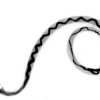Genetic Architects Untwist DNA’s Turns With Crispr
When scientists finished sequencing the human genome in 2003, many researchers focused their attention on decoding the long strings of As, Ts, Gs and Cs as the way to understanding the mysteries of human genetics. The genome, however, doesn’t appear in nature as a simple long line of letters. Unfurled, the genome stretches for nearly two meters, yet it folds itself in coils and loops to fit inside a nucleus less than 10 microns in diameter.
In recent years, researchers have begun to understand just how important this 3-D genetic architecture really is. Just as the only accessible information in a book is what’s on the open page in front of you, the genome’s instructions can only be read by the cell when those instructions aren’t hidden inside deep folds. But researchers don’t understand how the cell folds DNA in such a way that the important bits can be read.









































































